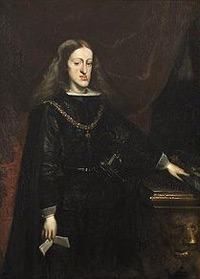Don’t marry your sister. It’s good advice, but one that the royalty often ignored. Scientific evidence confirms what we already knew. The following press release is a VERY ABBREVIATED recap of the paper itself:

The powerful Habsburg dynasty ruled Spain and its empire from 1516 to 1700 but when King Charles II died in 1700 without any children from his two marriages, the male line died out and the French Bourbon dynasty came to power in Spain. Reporting in the open-access, peer-reviewed journal PLoS ONE, April 15, Gonzalo Alvarez and colleagues at the University of Santiago de Compostela, Spain, provide genetic evidence to support the historical evidence that the high frequency of inbreeding (mating between closely related individuals) within the dynasty was a major cause for the extinction of its male line.
Using the genealogical information for Charles II and 3,000 of his relatives and ancestors across 16 generations, the researchers calculated the inbreeding coefficient (F) for each individual; this value indicates the probability that an individual receives, at a given locus, two genes identical by descent due to the common ancestry of its parents. They found that F increased considerably down the generations—from 0.025 for Philip I, the founder of the dynasty, to 0.254 for Charles II—as the Habsburg kings tended to marry close relatives more frequently in order to preserve their heritage. Several members of the dynasty had inbreeding coefficients higher than 0.20, which means that more than 20% of the genome is expected to be homozygous in these individuals.
The authors cite three lines of evidence to support the theory that inbreeding was a major factor in the extinction of the male Habsburg line, on the death of Charles II.
Firstly, there was a very high level of marriage between biological relatives (consanguineous marriage) within the Habsburg dynasty: nine of the 11 marriages over 200 years were consanguineous, including two uncle-niece marriages, one double-first-cousin marriage and one first-cousin marriage.
The two individuals with the highest inbreeding coefficient were Charles II and his grandfather Philip III. Although both were the sons of uncle-niece marriages, their F values were almost as high as the expected value for the offspring of an incestuous (parent-child or brother-sister) marriage. The researchers explain that this is likely to be due to multiple remote ancestors of these individuals (remote inbreeding), on top of the high degree of relatedness of their parents.
Secondly, there was a high rate of infant and child mortality in the Habsburg families with only half of the children born in the dynasty during the years studied surviving to age one, compared to about 80% in Spanish villages of the time. Alvarez and colleagues calculated that inbreeding at the level of first cousin (F = 0.0625) exerted an adverse effect on the survival to age 10 of offspring of 17.8 % ± 12.3, which could explain the high levels of infant and child mortality.
Thirdly, Charles II, dubbed El Hechizado (“The Hexed”), suffered from many different disorders and illnesses, some of which may result from the consanguineous marriage of his parents. According to contemporary writings he was short and weak and suffered from intestinal problems and sporadic hematuria. Children of closely consanguineous couples often have an increased incidence of detrimental health effects due to rare deleterious recessive alleles inherited from common ancestors, although this will depend on how inbred their pedigree is already.
Based on this clinical genetic knowledge and on information gathered by historians on the health of Charles II, Alvarez and colleagues speculate that the simultaneous occurrence of two different genetic disorders (combined pituitary hormone deficiency and distal renal tubular acidosis), determined by recessive alleles at two unlinked loci, could explain much of the complex clinical profile of this king, including his impotence/infertility, which led to the extinction of the dynasty.
CITATION: Alvarez G, Ceballos FC, Quinteiro C (2009) The Role of Inbreeding in the Extinction of a European Royal Dynasty. PLoS ONE.